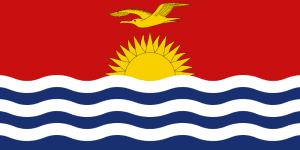
| Colors | HEX Code | RGB | CMYK |
|---|---|---|---|
| Red | #C81010 | 200, 16, 16 | 0, 92, 92, 22 |
| Yellow | #F8D000 | 248, 208, 0 | 0, 16, 100, 3 |
| White | #FFFFFF | 255, 255, 255 | 0, 0, 0, 0 |
| Blue | #183070 | 24, 48, 112 | 79, 57, 0, 56 |
The flag of Kiribati is made of yellow, red, blue and white colors. It features six wavy stripes of blue and white. Above the wavy stripes, there is a red field, featuring a 17-ray sun rising from the bottom of the red field, and above the sun, a gold frigate bird is flying.
Meaning of the Kiribati Flag
The blue stripes represent the Pacific Ocean. The white stripes represent the three groups of islands in the country. The 17 rays represent the 16 Kiribati islands and Banaba, an ocean Island. The yellow bird which is an indigenous bird, represents strength, power and freedom. It also represents the command of the sea. Its position above the sun depicts it as a guiding force. The sun refers to Kiribati’s position that straddles the Equator.
History of the Kiribati Flag
Kiribati is an island in the Pacific Ocean. It was a British protectorate in 1892, and its name was Gilbert Islands. When it gained independence in 1979, the name was changed to Kiribati. The flag was inspired by the coat of arms that was given to the country. Kiribati’s flag was designed by Sir Arthur Grimble, a former colonial officer. The flag was hoisted on the celebrations of independence and was officially adopted on July 12, 1979.